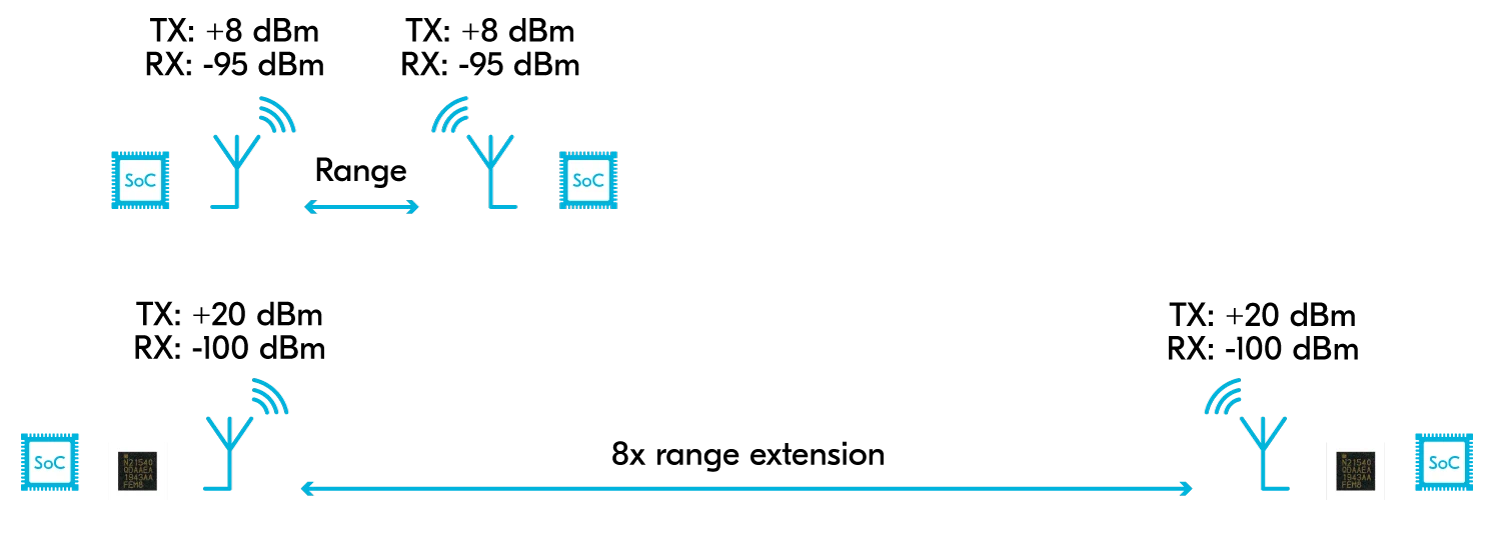Range extenders
Increasing range and link robustness
Increasing range
Boost your link budget with a range extender
The range and link robustness of Nordic nRF52 and nRF53 Series SoCs fulfill the requirements of most applications and use-cases, but sometimes adding an RF front-end module (FEM) is the correct choice. An RF FEM increases the range at which two wireless devices can communicate, while also enhancing link robustness. Combining our nRF21540 RF FEM with an nRF52 or nRF53 Series SoC can boost range between 6.3-10x.

In the image above, a regular connection with +8 dBm TX output power is compared to a +20 dBm TX output power connection with an nRF21540 RF FEM on both sides. Both the increased TX output power, as well as RX sensitivity improvements from the nRF21540 help boost the range of the connection. If using a Nordic SoC with less than +8 dBm TX output power, the range increase is even larger.
Be aware that a +20 dBm TX output power is not allowed in all regions. See the maximum regulatory output power table for more details.
Maximize link budget
Maximize your link budget while staying within regulatory boundaries
Both the TX output power and the receiver sensitivity directly influence the link budget of a connection.
After the Bluetooth 5 specification increased the maximum permissible output power to +20 dBm, device output power is now limited by regulatory boundaries in most regions.
Pairing the nRF21540 RF FEM with an nRF52 or nRF53 Series SoC enables fine-grained TX power tunability, resulting in a TX power at maximum 1 dBm below the regulatory limits mentioned below. The TX gain is dynamically adjustable, enabling the possibility of implementing adaptive gain control algorithms. When running 1 Mbps Bluetooth LE, the RX sensitivity improves to -100 dBm for all nRF52 and nRF53 Series SoCs. The sensitivity is even better when running Bluetooth Long Range, Thread or Zigbee.
Maximum regulatory TX output power table
The table below summarizes main regulatory output power limits in dBm EIRP. Please check the rules for the region you plan to ship your product into. FCC regulates wireless communication in USA, ETSI for Europe and ARIB for Japan.
* FCC has a max output power of +30 dBm, but Bluetooth SIG sets a limit to +20 dBm. On 125 kbps and 500 kbps, power spectral density regulations limits output power to 14 dBm. 802.15.4 is only limited by FCC regulations.
** ETSI has a limit of 10 dBm/1 MHz for 802.15.4. Although 802.15.4 specifies 5 MHz channel widths, only 2 MHz of the channel is consumed with the occupied bandwidth. Doubling the bandwidth to 2 MHz adds 3 dB, which leads to 13 dBm.
Maximum regulatory TX output power
| Organization | Bluetooth LE |
Bluetooth LE |
Bluetooth LE |
Bluetooth LE |
802.15.4 |
|---|---|---|---|---|---|
| Throughput |
125 kbps |
500 kbps |
1 Mbps |
2 Mbps |
250 kbps |
| FCC (USA) * |
14 | 14 |
20 |
20 |
30 |
| ETSI (Europe) |
10 | 10 | 10 | 10 |
13** |
| ARIB (Japan) |
10 | 10 | 10 |
10 |
10 |
| China | 10 | 10 | 10 | 10 | 10 |
| Korea | 10 | 10 | 10 | 10 | 10 |
Link robustness
Increases link stability
Why link robustness is important
In addition to increasing range, an RF FEM also increases the robustness of the link connection. A more robust link leads to less packet loss, meaning less retransmissions. Retransmissions are redundant packets that reduce energy efficiency and maximum throughput. The probability of successfully receiving the first packet also increases, resulting in a more stable link latency.
Applications
Enable and/or optimize your application with an RF FEM
Many applications can benefit from adding an RF FEM, including asset tracking, smart home, industrial, smart agriculture, audio, as well as professional lighting. Smart home and industrial applications, benefit from extended range (e.g. range in an entire home). Audio applications benefit via increased throughput and decreased latency. The image below shows the communication range of assets tracked in a factory with and without a range extender present.

Products
for 2.4 GHz range extension
nRF21540 RF FEM
RF front-end module (FEM) for Bluetooth® Low Energy, Bluetooth® mesh, 2.4 GHz proprietary and Thread and Zigbee
Supports Bluetooth® Low Energy, Bluetooth® mesh, Thread and Zigbee (802.15.4) and 2.4 GHz proprietary protocols
Tunable output power in small increments up to +21 dBm
13 dB RX gain with 2.7 dB noise figure
Two antenna ports for antenna diversity
TX gain control via I/Os, SPI, or a combination
-40 °C to 105 °C extended operating temperature range
1.7 to 3.6 V supply range
4x4 mm QFN16 package
Between 6.3-10x range extension when combined with an nRF52 or nRF53 Series SoC
Development hardware
for 2.4 GHz range extension
nRF21540 Development Bundle
The nRF21540 DB is the perfect development bundle to extend range of Bluetooth Low Energy, Bluetooth mesh, Thread, Zigbee and 2.4 GHz proprietary products together with the nRF21540 RF FEM. It includes the nRF21540 DK for application development and the nRF21540 EK for performance testing.







